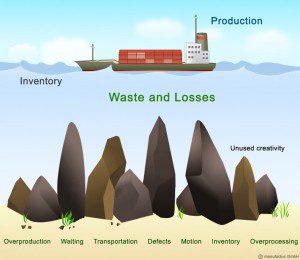Businesses throughout Australia are constantly looking to improve their competitiveness by increasing their productive output. With the Australian dollar and labour costs being all-time high, increase in productivity is the only way for many industries to remain competitive in the global markets. Manufacturers have for years been increasing their output per employee by the capital investments and process excellence initiatives, such as Lean Six Sigma. For many professional services firms, pressure comes from the need to increase profits in the depressed environment, where growth is often replaced by the improvement initiatives, designated to reduce their cost base. Even the smaller and private firms require productivity improvement simply to remain competitive and to absorb high Australian labour costs. Our client base generally consists of smaller professional firms that would all benefit from some of the activities taking place in the large business. Here are five ideas on how to improve the efficiency in (small to medium) office environment.
1. Define & strengthen your internal processes
The first step in any improvement initiative would be to involve employees and management in defining and documenting the existing processes. Power Point can now be used to develop some really good, visual process flows, making it very easy to highlight steps in even more complex processes. Having a clearly defined process removes uncertainty, makes it easy to suggest improvements and train new employees.
2. Involve employees in improvement initiatives
Involving employees in the improvement initiative will not only increase productivity due to better systems and less waste, but will also result in better morale and higher job satisfaction. Allowing employees to ‘taste the success’ of their own improvement work will also result in better buy-in and improvements that stick for longer. Lean Six Sigma approach is to focus improvement activities on the removal of eight wastes: Rework, Waiting, Transport, Inventory, Motion, Over-processing, Overproduction and Non-utilised talents. At least some of these apply to every office environment and make a great start for an improvement work.
 3. Visualise your office performance
3. Visualise your office performance
 Humans are highly visual creatures. It is always easier to understand and remember a story that is accompanied by some kind of an image than a written text or numbers alone. By using graphic representation of performance and daily attention to these graphed metrics, businesses have often made significant productivity improvements with minimum or no spend at all. All that is needed is a whiteboard or a corkboard attached to the wall; A3 graph paper for each important metric and some green and red pens; with green being performance on target and red being below target performance.
Humans are highly visual creatures. It is always easier to understand and remember a story that is accompanied by some kind of an image than a written text or numbers alone. By using graphic representation of performance and daily attention to these graphed metrics, businesses have often made significant productivity improvements with minimum or no spend at all. All that is needed is a whiteboard or a corkboard attached to the wall; A3 graph paper for each important metric and some green and red pens; with green being performance on target and red being below target performance.
4. Select IT solutions that do not overload your budget
Quite often, IT solutions are sold as ‘the magic wand’ that rarely deliver on the initial promises and the prescribed capacity. We see so many applications that cost a lot, are used sparsely, are disliked by the employees and quickly become obsolete. The problem is that quite often a single application is sold as the all-in-one solution. The truth is that there are several applications that cost little, integrate well with each other, are easy to use and are maintained as the part of the package. These applications are nearly always cloud based, with pay-as-you-go pricing model that is over time significantly cheaper that some traditional applications used by the professional firms. An example of such arrangement is CRM system that cost little per user, talks to your email software and use external email marketing provider. These systems work exceptionally well, are easy to use and each component performs better that all-in-one solutions.
5. Introduce flexible labour practices
Businesses with rigid labour arrangements are often left stranded when their key employees leave or end up with dis-proportionally high labour cost. Expansion is often limited due to difficulties in finding right employees and inability to pay for the talent. Having flexible work arrangements, with a mix of full time, part time and outsourced/contract labour often provides a great platform for growth and more productive environment. All of these suggestions require some time to plan and implement correctly. However, apart from time they don’t require any capital and little ongoing costs. Once in place, productivity benefits will significantly outweigh any investment costs.